Anna Wang
An Approach to Technical AGI Safety and Security
Apr 02, 2025Abstract:Artificial General Intelligence (AGI) promises transformative benefits but also presents significant risks. We develop an approach to address the risk of harms consequential enough to significantly harm humanity. We identify four areas of risk: misuse, misalignment, mistakes, and structural risks. Of these, we focus on technical approaches to misuse and misalignment. For misuse, our strategy aims to prevent threat actors from accessing dangerous capabilities, by proactively identifying dangerous capabilities, and implementing robust security, access restrictions, monitoring, and model safety mitigations. To address misalignment, we outline two lines of defense. First, model-level mitigations such as amplified oversight and robust training can help to build an aligned model. Second, system-level security measures such as monitoring and access control can mitigate harm even if the model is misaligned. Techniques from interpretability, uncertainty estimation, and safer design patterns can enhance the effectiveness of these mitigations. Finally, we briefly outline how these ingredients could be combined to produce safety cases for AGI systems.
Evaluating Compositional Scene Understanding in Multimodal Generative Models
Mar 29, 2025Abstract:The visual world is fundamentally compositional. Visual scenes are defined by the composition of objects and their relations. Hence, it is essential for computer vision systems to reflect and exploit this compositionality to achieve robust and generalizable scene understanding. While major strides have been made toward the development of general-purpose, multimodal generative models, including both text-to-image models and multimodal vision-language models, it remains unclear whether these systems are capable of accurately generating and interpreting scenes involving the composition of multiple objects and relations. In this work, we present an evaluation of the compositional visual processing capabilities in the current generation of text-to-image (DALL-E 3) and multimodal vision-language models (GPT-4V, GPT-4o, Claude Sonnet 3.5, QWEN2-VL-72B, and InternVL2.5-38B), and compare the performance of these systems to human participants. The results suggest that these systems display some ability to solve compositional and relational tasks, showing notable improvements over the previous generation of multimodal models, but with performance nevertheless well below the level of human participants, particularly for more complex scenes involving many ($>5$) objects and multiple relations. These results highlight the need for further progress toward compositional understanding of visual scenes.
A Framework for Evaluating Emerging Cyberattack Capabilities of AI
Mar 14, 2025Abstract:As frontier models become more capable, the community has attempted to evaluate their ability to enable cyberattacks. Performing a comprehensive evaluation and prioritizing defenses are crucial tasks in preparing for AGI safely. However, current cyber evaluation efforts are ad-hoc, with no systematic reasoning about the various phases of attacks, and do not provide a steer on how to use targeted defenses. In this work, we propose a novel approach to AI cyber capability evaluation that (1) examines the end-to-end attack chain, (2) helps to identify gaps in the evaluation of AI threats, and (3) helps defenders prioritize targeted mitigations and conduct AI-enabled adversary emulation to support red teaming. To achieve these goals, we propose adapting existing cyberattack chain frameworks to AI systems. We analyze over 12,000 instances of real-world attempts to use AI in cyberattacks catalogued by Google's Threat Intelligence Group. Using this analysis, we curate a representative collection of seven cyberattack chain archetypes and conduct a bottleneck analysis to identify areas of potential AI-driven cost disruption. Our evaluation benchmark consists of 50 new challenges spanning different phases of cyberattacks. Based on this, we devise targeted cybersecurity model evaluations, report on the potential for AI to amplify offensive cyber capabilities across specific attack phases, and conclude with recommendations on prioritizing defenses. In all, we consider this to be the most comprehensive AI cyber risk evaluation framework published so far.
Turbo your multi-modal classification with contrastive learning
Sep 14, 2024



Abstract:Contrastive learning has become one of the most impressive approaches for multi-modal representation learning. However, previous multi-modal works mainly focused on cross-modal understanding, ignoring in-modal contrastive learning, which limits the representation of each modality. In this paper, we propose a novel contrastive learning strategy, called $Turbo$, to promote multi-modal understanding by joint in-modal and cross-modal contrastive learning. Specifically, multi-modal data pairs are sent through the forward pass twice with different hidden dropout masks to get two different representations for each modality. With these representations, we obtain multiple in-modal and cross-modal contrastive objectives for training. Finally, we combine the self-supervised Turbo with the supervised multi-modal classification and demonstrate its effectiveness on two audio-text classification tasks, where the state-of-the-art performance is achieved on a speech emotion recognition benchmark dataset.
DSCLAP: Domain-Specific Contrastive Language-Audio Pre-Training
Sep 14, 2024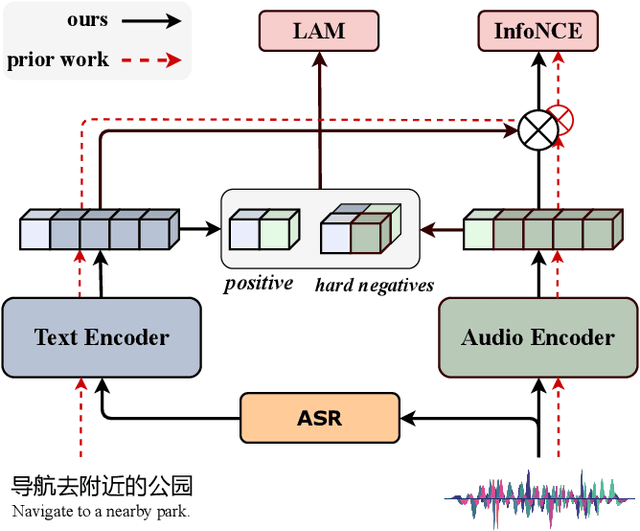

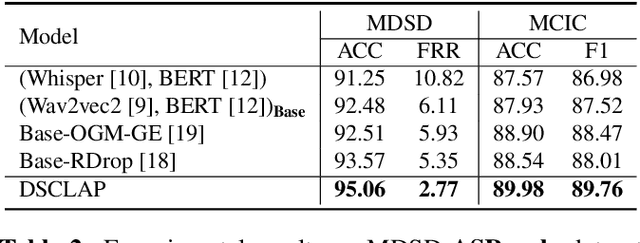
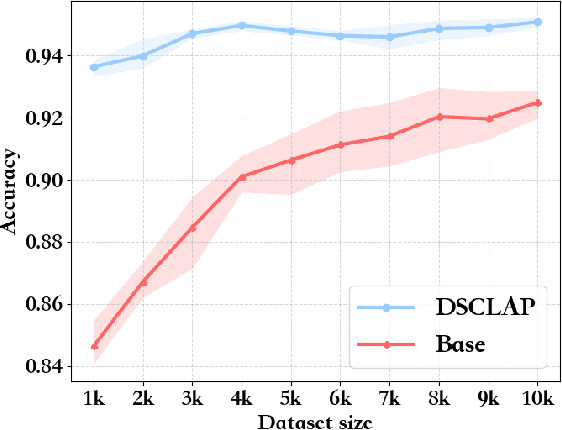
Abstract:Analyzing real-world multimodal signals is an essential and challenging task for intelligent voice assistants (IVAs). Mainstream approaches have achieved remarkable performance on various downstream tasks of IVAs with pre-trained audio models and text models. However, these models are pre-trained independently and usually on tasks different from target domains, resulting in sub-optimal modality representations for downstream tasks. Moreover, in many domains, collecting enough language-audio pairs is extremely hard, and transcribing raw audio also requires high professional skills, making it difficult or even infeasible to joint pre-training. To address these painpoints, we propose DSCLAP, a simple and effective framework that enables language-audio pre-training with only raw audio signal input. Specifically, DSCLAP converts raw audio signals into text via an ASR system and combines a contrastive learning objective and a language-audio matching objective to align the audio and ASR transcriptions. We pre-train DSCLAP on 12,107 hours of in-vehicle domain audio. Empirical results on two downstream tasks show that while conceptually simple, DSCLAP significantly outperforms the baseline models in all metrics, showing great promise for domain-specific IVAs applications.
M$^{3}$V: A multi-modal multi-view approach for Device-Directed Speech Detection
Sep 14, 2024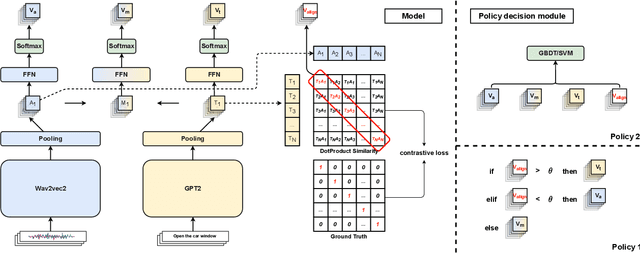

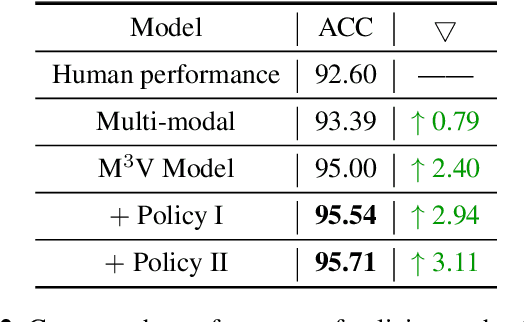
Abstract:With the goal of more natural and human-like interaction with virtual voice assistants, recent research in the field has focused on full duplex interaction mode without relying on repeated wake-up words. This requires that in scenes with complex sound sources, the voice assistant must classify utterances as device-oriented or non-device-oriented. The dual-encoder structure, which is jointly modeled by text and speech, has become the paradigm of device-directed speech detection. However, in practice, these models often produce incorrect predictions for unaligned input pairs due to the unavoidable errors of automatic speech recognition (ASR).To address this challenge, we propose M$^{3}$V, a multi-modal multi-view approach for device-directed speech detection, which frames we frame the problem as a multi-view learning task that introduces unimodal views and a text-audio alignment view in the network besides the multi-modal. Experimental results show that M$^{3}$V significantly outperforms models trained using only single or multi-modality and surpasses human judgment performance on ASR error data for the first time.
Deep learning-assisted imaging through stationary scattering media
Feb 25, 2022



Abstract:Imaging through scattering media is a challenging problem owing to speckle decorrelations from perturbations in the media itself. For in-line imaging modalities, which are appealing because they are compact, require no moving parts, and are robust, negating the effects of such scattering becomes particularly challenging. Here we explore the effect of stationary scattering media on light scattering in in-line geometries, including digital holographic microscopy. We consider various object-scatterer scenarios where the object is distorted or obscured by additional stationary scatterers, and use an advanced deep learning (DL) generative methodology, generative adversarial networks (GANs), to mitigate the effects of the additional scatterers. Using light scattering simulations and experiments on objects of interest with and without additional scatterers, we find that conditional GANs can be quickly trained with minuscule datasets and can also efficiently learn the one-to-one statistical mapping between the cross-domain input-output image pairs. Training such a network yields a standalone model, that can be used later to inverse or negate the effect of scattering, yielding clear object reconstructions for object retrieval and downstream processing. Moreover, it is well-known that the coherent point spread function (c-PSF) of a stationary scattering optical system is a speckle pattern which is spatially shift variant. We show that with rapid training using only 20 image pairs, it is possible to negate this undesired scattering to accurately localize diffraction-limited impulses with high spatial accuracy, therefore transforming the earlier shift variant system to a linear shift invariant (LSI) system.
 Add to Chrome
Add to Chrome Add to Firefox
Add to Firefox Add to Edge
Add to Edge